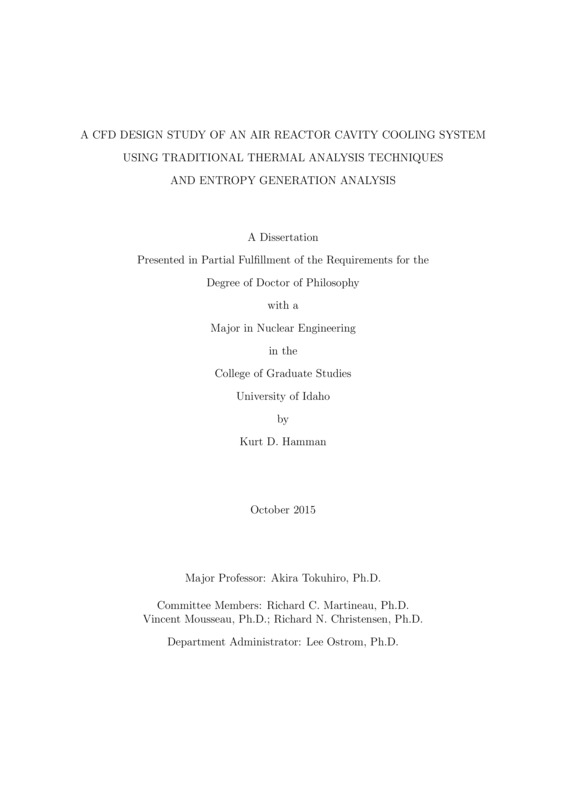A CFD DESIGN STUDY OF AN AIR REACTOR CAVITY COOLING SYSTEM USING TRADITIONAL THERMAL ANALYSIS TECHNIQUES AND ENTROPY GENERATION ANALYSIS
Hamman, Kurt. (2015). A CFD DESIGN STUDY OF AN AIR REACTOR CAVITY COOLING SYSTEM USING TRADITIONAL THERMAL ANALYSIS TECHNIQUES AND ENTROPY GENERATION ANALYSIS. Theses and Dissertations Collection, University of Idaho Library Digital Collections. https://www.lib.uidaho.edu/digital/etd/items/hamman_idaho_0089e_10542.html
- Title:
- A CFD DESIGN STUDY OF AN AIR REACTOR CAVITY COOLING SYSTEM USING TRADITIONAL THERMAL ANALYSIS TECHNIQUES AND ENTROPY GENERATION ANALYSIS
- Author:
- Hamman, Kurt
- Date:
- 2015
- Keywords:
- Boundary Layer Computational Fluid Dynamics Entropy Generation Analysis Modeling and Simulation Rector Cavity Cooling System Verification and Validation
- Program:
- Mechanical Engineering
- Subject Category:
- Nuclear engineering; Mechanical engineering
- Abstract:
-
Current research in advanced reactor designs has focused on passive safety systems, where in the event of a loss of cooling to the reactor core, excess heat will be removed by a passive safety heat removal system. A safety system is classified as `passive' because it does not require a pump to circulate the fluid (i.e., forced circulation) or operator action to maintain cooling. The system relies on the natural circulation of a fluid (i.e., fluid density differences and gravity) to transfer the heat. Passive safety system designs include features that enhance natural circulation, such as using smooth pipes, minimizing flow obstructions, and maximizing density differences, which increase fluid velocity and hence the removal of more heat.
This research consisted of a CFD study of wall-bounded transitional flows and a passive reactor cavity cooling system. Yet in an effort to better understand fundamental phenomena, relative to the limits of natural circulation turbulence modeling, only forced circulation CFD analyses were performed. The initial phase of this research consisted of two types of CFD studies: 2D entropy generation rate boundary layer analyses of an isothermal transitional fluid flow over a flat plate, and 3D thermal performance analyses of a 1/4-scale experimental air reactor cavity cooling system. The 2D flat plate boundary layer studies were important in that they provided insight into flow features, such as boundary layer development and entropy generation rate, in the 3D RCCS ducts as the air transitions from laminar to turbulent flow.
Using the results of the initial study as a baseline, this work analyzed the viscous and thermal boundary layer development, including estimating the entropy generation rate, in the heated duct section of the RCCS, which is characterized by nonuniform flow and heat transfer. A new engineering design process was developed, which incorporates not only traditional heat transfer and fluid flow (HTFF) analysis techniques but entropy generation minimization (EGM) concepts as well. This analysis process was successfully applied to the existing 1/4-scale experimental air RCCS, resulting in the identification of the primary entropy dissipation mechanism and an improved design.
- Description:
- doctoral, Ph.D., Mechanical Engineering -- University of Idaho - College of Graduate Studies, 2015
- Major Professor:
- Tokuhiro, Akira
- Committee:
- Martineau, Richard C; Mousseau, Vincent; Christensen, Richard N
- Defense Date:
- 2015
- Identifier:
- Hamman_idaho_0089E_10542
- Type:
- Text
- Format Original:
- Format:
- application/pdf
- Rights:
- In Copyright - Educational Use Permitted. For more information, please contact University of Idaho Library Special Collections and Archives Department at libspec@uidaho.edu.
- Standardized Rights:
- http://rightsstatements.org/vocab/InC-EDU/1.0/

